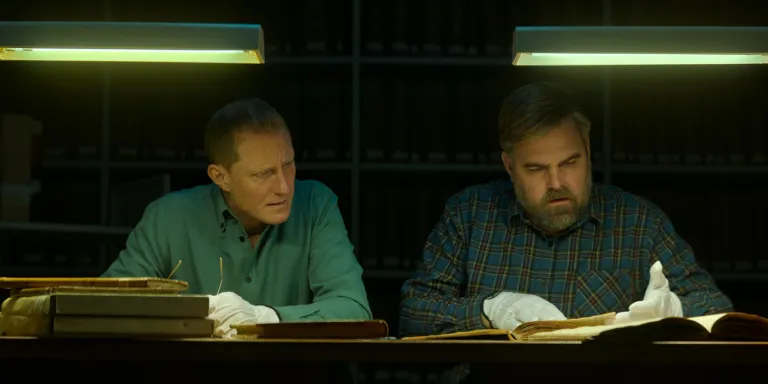Netflix’s Swedish crime drama Genombrottet, internationally known as The Breakthrough, delves into a chilling murder mystery that gripped the city of Linköping for over 16 years. Two brutal killings—one of a young boy named Adnan and another of an elderly woman named Gunilla—set the story in motion.
Detective John Sundin takes on the case with unwavering determination, but despite an eyewitness and years of investigation, the killer remains unidentified. As time dwindles and the case nears closure as a cold case, John teams up with genealogist Per Skogkvist, hoping a revolutionary approach will finally crack the mystery.
The Breakthrough Recap
On October 19, 2004, tragedy strikes the city of Linköping. Adnan Abbas, a middle schooler, is attacked and fatally stabbed while walking to school. Gunilla, an elderly woman, witnesses the attack and intervenes, only to be stabbed herself. Her screams attract a passerby, Karin, who inadvertently allows the killer to escape. The shocking murders leave the city in turmoil as the police arrive on the scene.
Detective John Sundin, known for his dedication and athletic past, leads the investigation. Initially, hope is high—Karin witnessed the killer, and DNA is recovered from the crime scene. However, Karin’s inability to recall the killer’s face and the lack of a DNA match leave the case at a standstill. The police conduct mass DNA screenings of men between 15 and 30, but the efforts yield no results. As the investigation drags on, John maintains contact with the victims’ families, shouldering their grief and frustrations.

John’s obsession with solving the case takes a toll on his personal life. His wife, Anna, struggles with his emotional unavailability as he becomes consumed by his work. Even after years, John’s relentless pursuit of justice leaves him no closer to catching the killer. When his department threatens to shut down the investigation, John turns to cutting-edge DNA genealogy technology, hoping it will provide the breakthrough he desperately needs.
How Does John Catch the Killer?
John’s chance encounter with Per Skogkvist, a genealogist, sparks new hope. Per specializes in tracing ancestry through public records and DNA databases, though his work had largely been dismissed as a tool for uncovering family secrets. John convinces Per to assist with the investigation, though they face legal and ethical challenges due to Sweden’s strict privacy laws.
The case takes a critical turn when Per analyzes the DNA sample collected from a beanie found at the crime scene. Although initial results only reveal the killer’s German ancestry, Per uses genealogical methods to trace familial connections. The breakthrough comes when journalist Stina agrees to provide her DNA, expanding Per’s database. Her contribution helps Per identify two brothers, David and Stefan Nilsson, as potential suspects.
David, a reclusive individual with anti-social tendencies, becomes the prime suspect. Once his DNA is confirmed as a match, the police arrest him. During his interrogation, David confesses, citing voices in his head that compelled him to kill. His mental instability and lack of motive beyond his delusions underscore the senselessness of the crimes. With the case finally solved, John fulfills his promise to the victims’ families, bringing them long-awaited closure.
Who is the Killer? What was His Motive?
David Nilsson is revealed as the killer. A socially withdrawn individual, David’s confession points to severe psychological issues. He claims he was driven to kill by voices in his head, which told him that taking two lives would grant him peace. His crimes lacked personal motives, making them all the more harrowing. Despite his confession and the DNA evidence, David’s mental state raises questions about his accountability.

While the arrest and confession resolve the case on paper, they leave an unsettling impression of the randomness and brutality of the murders. David’s lack of connection to the victims emphasizes the fragile nature of safety and the unpredictability of violence.
Why Couldn’t John Give Up on the Case?
John Sundin’s relentless pursuit of the killer stems from both professional duty and personal investment. From the outset, John promises the victims’ families justice, embedding himself in their pain and trauma. This connection drives him to push beyond conventional methods, even as the investigation jeopardizes his marriage and personal well-being.
The case becomes more than a professional obligation for John—it consumes his identity. Abandoning the investigation would mean accepting failure, not only for himself but for the victims and their families. His guilt over unfulfilled promises and the weight of public expectation further fuel his obsession.
When John partners with Per, he recognizes an opportunity to reclaim control of the case and make good on his commitments. The eventual resolution allows John to begin healing, both personally and professionally. Solving the case provides a sense of closure for the families and an opportunity for John to rebuild his fractured relationship with his son.
Conclusion
The Breakthrough delivers a gripping narrative that highlights the complexities of justice, obsession, and closure. John Sundin’s unwavering dedication ensures that the victims’ families receive the answers they deserve, even after 16 years of uncertainty. The use of DNA genealogy not only solves the case but also underscores the potential of emerging technologies in criminal investigations. David Nilsson’s confession, while resolving the mystery, serves as a stark reminder of the randomness of violence and the devastating impact it can have on individuals and communities. Ultimately, the series captures the perseverance required to seek justice and the emotional toll it exacts on all involved.

